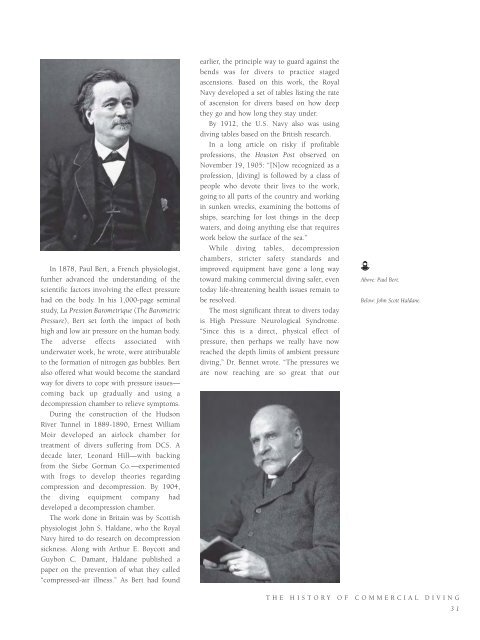Working Underwater: The Story of the Commercial Diving Industry
An illustrated history of the commercial diving industry paired with the histories of companies that have helped shape the industry.
An illustrated history of the commercial diving industry paired with the histories of companies that have helped shape the industry.
Create successful ePaper yourself
Turn your PDF publications into a flip-book with our unique Google optimized e-Paper software.
In 1878, Paul Bert, a French physiologist,<br />
fur<strong>the</strong>r advanced <strong>the</strong> understanding <strong>of</strong> <strong>the</strong><br />
scientific factors involving <strong>the</strong> effect pressure<br />
had on <strong>the</strong> body. In his 1,000-page seminal<br />
study, La Pression Barometrique (<strong>The</strong> Barometric<br />
Pressure), Bert set forth <strong>the</strong> impact <strong>of</strong> both<br />
high and low air pressure on <strong>the</strong> human body.<br />
<strong>The</strong> adverse effects associated with<br />
underwater work, he wrote, were attributable<br />
to <strong>the</strong> formation <strong>of</strong> nitrogen gas bubbles. Bert<br />
also <strong>of</strong>fered what would become <strong>the</strong> standard<br />
way for divers to cope with pressure issues—<br />
coming back up gradually and using a<br />
decompression chamber to relieve symptoms.<br />
During <strong>the</strong> construction <strong>of</strong> <strong>the</strong> Hudson<br />
River Tunnel in 1889-1890, Ernest William<br />
Moir developed an airlock chamber for<br />
treatment <strong>of</strong> divers suffering from DCS. A<br />
decade later, Leonard Hill—with backing<br />
from <strong>the</strong> Siebe Gorman Co.—experimented<br />
with frogs to develop <strong>the</strong>ories regarding<br />
compression and decompression. By 1904,<br />
<strong>the</strong> diving equipment company had<br />
developed a decompression chamber.<br />
<strong>The</strong> work done in Britain was by Scottish<br />
physiologist John S. Haldane, who <strong>the</strong> Royal<br />
Navy hired to do research on decompression<br />
sickness. Along with Arthur E. Boycott and<br />
Guybon C. Damant, Haldane published a<br />
paper on <strong>the</strong> prevention <strong>of</strong> what <strong>the</strong>y called<br />
“compressed-air illness.” As Bert had found<br />
earlier, <strong>the</strong> principle way to guard against <strong>the</strong><br />
bends was for divers to practice staged<br />
ascensions. Based on this work, <strong>the</strong> Royal<br />
Navy developed a set <strong>of</strong> tables listing <strong>the</strong> rate<br />
<strong>of</strong> ascension for divers based on how deep<br />
<strong>the</strong>y go and how long <strong>the</strong>y stay under.<br />
By 1912, <strong>the</strong> U.S. Navy also was using<br />
diving tables based on <strong>the</strong> British research.<br />
In a long article on risky if pr<strong>of</strong>itable<br />
pr<strong>of</strong>essions, <strong>the</strong> Houston Post observed on<br />
November 19, 1905: “[N]ow recognized as a<br />
pr<strong>of</strong>ession, [diving] is followed by a class <strong>of</strong><br />
people who devote <strong>the</strong>ir lives to <strong>the</strong> work,<br />
going to all parts <strong>of</strong> <strong>the</strong> country and working<br />
in sunken wrecks, examining <strong>the</strong> bottoms <strong>of</strong><br />
ships, searching for lost things in <strong>the</strong> deep<br />
waters, and doing anything else that requires<br />
work below <strong>the</strong> surface <strong>of</strong> <strong>the</strong> sea.”<br />
While diving tables, decompression<br />
chambers, stricter safety standards and<br />
improved equipment have gone a long way<br />
toward making commercial diving safer, even<br />
today life-threatening health issues remain to<br />
be resolved.<br />
<strong>The</strong> most significant threat to divers today<br />
is High Pressure Neurological Syndrome.<br />
“Since this is a direct, physical effect <strong>of</strong><br />
pressure, <strong>the</strong>n perhaps we really have now<br />
reached <strong>the</strong> depth limits <strong>of</strong> ambient pressure<br />
diving,” Dr. Bennet wrote. “<strong>The</strong> pressures we<br />
are now reaching are so great that our<br />
Above: Paul Bert.<br />
Below: John Scott Haldane.<br />
THE HISTORY OF COMMERCIAL DIVING<br />
31
















